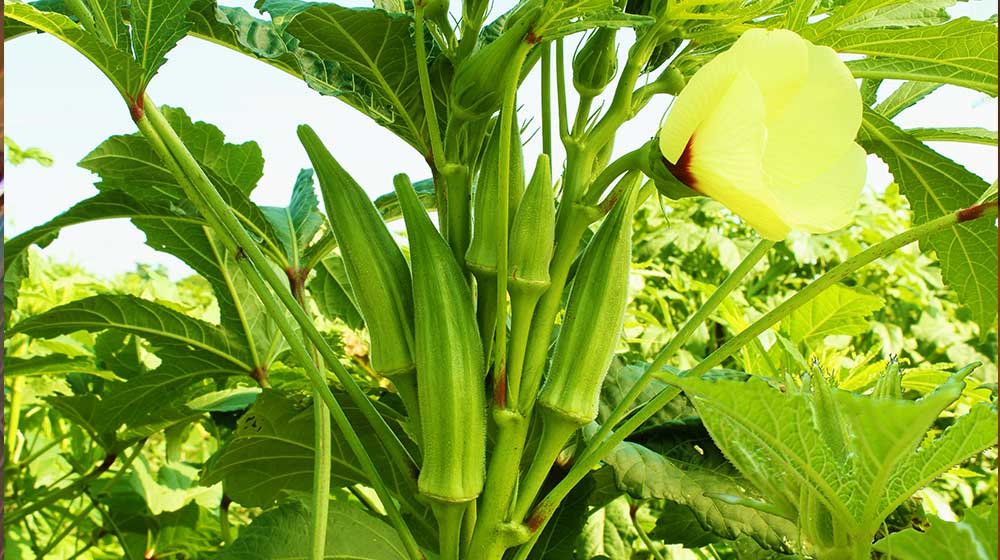Growing okra this Summer is pretty easy. Sometimes called ladies fingers, okra makes a good addition to your vegetable garden and to your gumbo, soup, and fried dishes.
Okra plant is popular in the South but is starting to make its way to many American gardens. In this article, I’ll be showing you how simple growing okra is.
RELATED: 25 Perfect Summer Garden Crops For A Bountiful Harvest
Growing Okra in Your Backyard Garden
When to Plant Okra
[instagram url=https://www.instagram.com/p/B2r3C7fgq_q/ hidecaption=true width=800]
The perfect time to start your okra is when the weather becomes warm and stable, around 65° – 75°F. In the United States, this usually falls in late Spring up to early Summer.
If you’re planting early and are afraid of the last frost, you can cover the plant with grow tunnel for protection. Some gardeners start the seeds indoor at least three weeks before planting in soil. Though this is possible, I advise against it because the tiny secondary roots of the plant are fragile.
How to Grow Okra
Step 1. Choose the Planting Site
[instagram url=https://www.instagram.com/p/CA2VFaVFBUW/ hidecaption=true width=800]
Lady’s fingers (okra) love the sun! When choosing an area in your garden, find the one with the longest exposure to the sun (at least 8 hours per day). However, okras grow erect and tall, but their stems are fragile. You need to consider the wind in your area as well.
In terms of soil composition, fast-draining sandy loams are best for growing okra with a soil pH between 5.6 to 7.0.
Don’t plant okra in the same soil where you planted tomatoes and eggplants. The fungal wilt from the previous growth tends to last even after harvest.
[amazon box=”B07BR52P26 , B00P71A7L4″ grid=”3″ price=”none” button_text=”Check it out”]
Step 2. Prepare the Okra Seeds
Once you’ve chosen a variety of okra to grow, it’s time to sow. Great varieties include Cajun Delight, Clemson Spineless, Emerald, and Green Velvet.
Before sowing, you must soak the okra seeds in water for 12-18 hours. This process rehydrates and readies the seed for germination.
Step 3. Sow the Seeds
[instagram url=https://www.instagram.com/p/CAEOh5vlQrD/ hidecaption=true width=800]
Sow the seeds 1/2- to 1-inch in the soil. Cover the seeds gently with soil and water. Since okra will need full sun, space your plants at least 1 foot apart.
If you’re going for container gardening, choose a tall planter to allow the roots to run deep. Planting okras in pots is advisable if you don’t have a spot where there is full sun all day. This way, you can carefully move the planter to follow the sun.
RELATED: 10 Easy Vegetable Gardening Tips To Achieve An Abundant Harvest
Step 4. Care for the Okra Plant
As mentioned, full sun exposure is the number one priority for growing okra.
You need to frequently water the growing okra plant until it starts flowering. After that, you can settle to once-a-week 1-inch watering. Water directly the soil and avoid getting the leaves wet. To be safe, water early in the morning to allow the sun to dry leaves you accidentally water.
Adding a healthy amount of compost will help enrich the soil. Side-dish your okra plant with slow-release organic fertilizers in the first few weeks of development. After growing about 10 inches in height, your growing okra plant will do good without supplemental fertilizer.
When the plant reaches at least 3 feet, prune the lower branches to encourage the plant to flower and fruit on higher branches near the sun.
Expert Advice: When pruning, wear gloves and garden gears because the plant has hairy stems that cause irritations to some people.
Step 5. Fight Off Pests and Diseases
[instagram url=https://www.instagram.com/p/BpuNu2fAFBK/ hidecaption=true width=800]
Although okra is a tough plant, it is still affected by common Summer diseases and bugs. On top of the list is the stinking bugs. They attack the pods resulting inn deformed fruits. You can spray soap insecticides to ward them off.
Other pests that can attack your okra plant include aphids and corn earworms. Treat the plant with neem oil or the stronger organic spinosad insecticides.
Okra plants are vulnerable to root rot or fusarium wilt. Preventive action for this is to not overwater the plant.
[amazon box=”B0716JF8MB , B000BWY3OQ” grid=”3″ price=”none” button_text=”Check it out”]
Step 6. Harvest the Okra Pods
Okra plants are fast-growing crops. In about 60-75 days, the fruits will be ready for harvest. The pods should be good for picking if it’s about 3 inches long. Harvest every other day.
Use a knife to cut the stem just above the cap of the pod. You’ll know when the pods are too old for harvest when it’s harder to cut through the stem. You can dry these and keep the seeds for planting in the next growing season. Beware of the hairy spines when harvesting.
If you have harvest more than what you need, you can wash, dry, and store them in a freezer.
Watch this video from Scott Head on how to grow ladies fingers (okra) in containers:
That was quick and simple, right? Okra or ladies fingers are good addition to your vegetable garden, and growing them is really easy and appropriate for the warming weather.
Now that I’ve shown you how to grow okra from seed, what are you waiting for? Purchase seeds and start planting these Summer vegetable!
Aside from okra, what other Summer crops would you like to try growing in your own garden? Let us know in the comments section below.
Up Next:
- Fastest Growing Vegetables To Plant For A Quick Harvest
- How To Keep Plants Alive In The Summer Heat Wave | 11 Tips
- How To Make A DIY Upside Down Planter
Calling all green thumbs, Garden Season needs YOU! Click here if you want to contribute for us!
Want to stay up to date? Follow Garden Season on Facebook, Twitter, Instagram, and Pinterest.



